Indonesia is a country in Southeast Asia that consists entirely of islands—more than 17,500 of them. The islands of Indonesia stretch across more than 3,200 miles (5,150 kilometers) of tropical ocean along the equator. Indonesia has the fourth largest population in the world. Only India, China, and the United States have more people. Indonesia occupies a strategic position in Southeast Asia, and its political and economic conditions are important to the stability of the region.
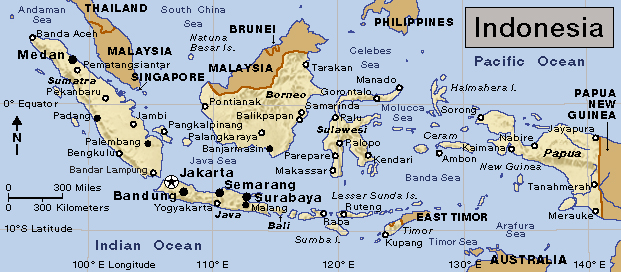
Indonesia has an extremely diverse population. Its people belong to about 300 different ethnic groups and speak more than 250 languages. They had no common language until the late 1920’s, when Indonesian nationalists provided one by creating a new language called Bahasa Indonesia, a modified form of the Malay language. Bahasa Indonesia, which means language of Indonesia, became a force for national unity.
Another unifying force is Islam. Most of Indonesia’s people are Muslims, and they make up the world’s largest Muslim population.
Indonesia is rich in natural resources. Many of its islands were formed by volcanoes, so they are mountainous and rise steeply from the sea. Much of the soil is especially fertile because it contains volcanic ash, which is rich in nutrients. The rich soil supports bountiful fields of rice, and Indonesia ranks among the world’s leading rice producers. Other major farm products include cocoa, coffee, palm oil, rubber, sugar, and tea. Lush tropical rain forests cover about one-half of Indonesia. Teak and other valuable hardwood trees grow in the forests of Indonesia, and rare plants and animals live there. Elephants, rhinoceroses, and tigers roam among the trees. Underground lie deposits of oil, natural gas, bauxite, coal, copper, gold, nickel, silver, and tin. 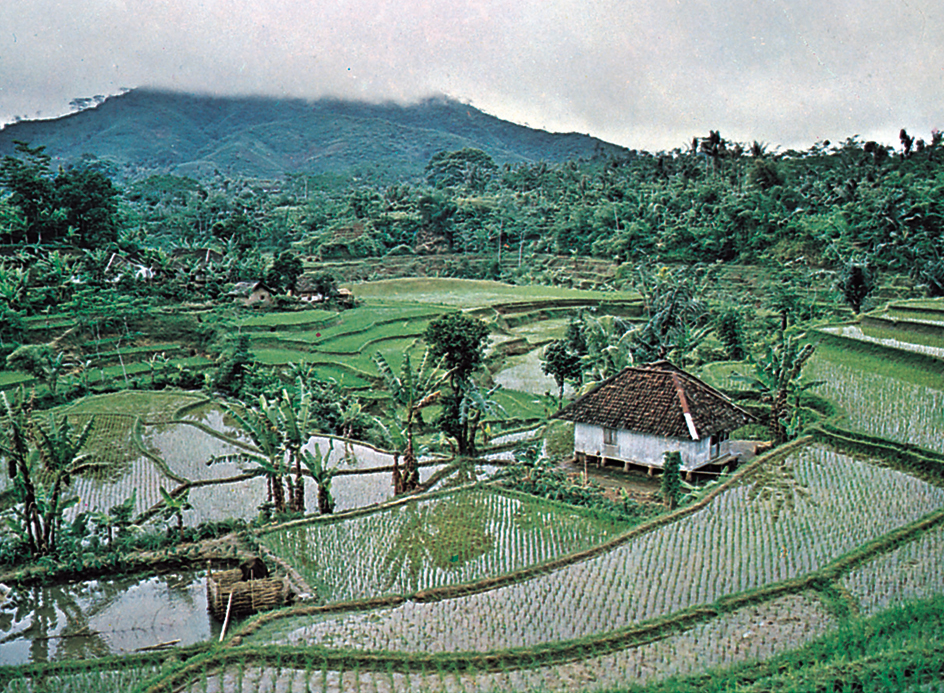
The Netherlands ruled Indonesia during most of the period from the 1600’s to 1945. Indonesia declared its independence in 1945 and fought the Dutch until 1949, when they gave up their control.
Government
National government.
The Indonesian government is based on a set of beliefs known as Pancasila. Pancasila consists of five principles: (1) belief in one God, (2) humanitarianism, (3) the unity of Indonesia, (4) democracy based on deliberation and consensus among representatives, and (5) social justice for all people. Sukarno, Indonesia’s first president, set forth the principles of Pancasila in 1945 and made it an official state doctrine. Indonesian law requires all religious, professional, and cultural organizations to adopt Pancasila. Some Islamic organizations, however, object to the government’s policy of making religious traditions secondary to Pancasila.
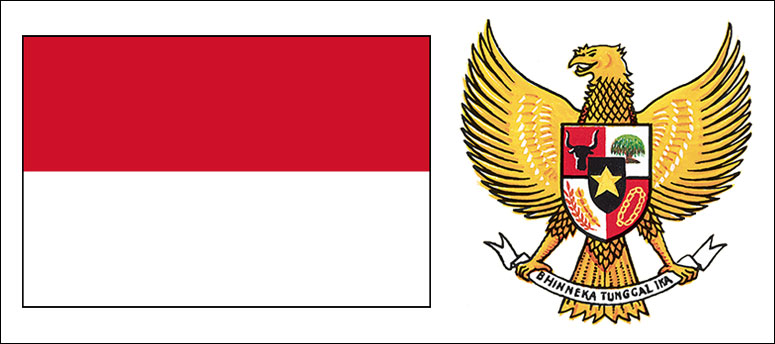
The Constitution of Indonesia was written in 1945. According to this document, a House of Representatives makes the nation’s laws. The House meets yearly. Another body, called the People’s Consultative Assembly, has the authority to amend the Constitution. The Assembly consists of the 575 members of the House, plus the smaller Regional Representatives Council, which includes four members from each of Indonesia’s provinces. Members of both the House and the regional council are elected by the people to five-year terms.
Loading the player...Indonesia's national anthem
The president is chief of state, head of the government, and commander of the armed forces. The president appoints a Cabinet to assist in running the government. The president is elected by the people to a five-year term and is limited to two terms.
Local government.
Indonesia has 38 major political divisions—35 provinces, 1 autonomous (self-governing) province (Aceh, in northern Sumatra), 1 special region (the city of Yogyakarta), and 1 national capital district (Jakarta Raya, which includes the capital city of Jakarta and the surrounding area). The people in each province elect a governor. The provinces are divided into districts and municipalities.
Politics.
Until 1998, Indonesia’s most important political organization was Golkar. Golkar was a federation of a number of groups, including labor and the military. It was technically not a political party, but it sponsored most of the candidates in elections. Indonesia’s laws ensured that Golkar candidates won a majority of seats in the legislature.
In 1998, President Suharto, who had dominated the country and its politics since the 1960’s, resigned. Following Suharto’s resignation, Golkar remained influential, but a number of new political parties emerged. The Indonesian Democratic Party of Struggle, which had existed as a party under Suharto, has become a major party in Indonesia. Other important parties now include the Great Indonesia Movement Party (Gerinda), the National Awakening Party, and the National Democratic Party (Nasdem).
Courts.
Indonesia has district courts, high courts, military courts, and special religious courts that handle personal matters among Muslims, such as divorces and inheritances. Indonesia also has a Constitutional Court that determines whether laws passed by the House of Representatives are constitutional. The highest court is the Supreme Court. It reviews cases appealed from the high courts and settles disputes between courts in different regions or between the religious courts and other courts. A Judicial Commission nominates candidates to serve as judges of the Supreme Court. Indonesia’s president may then appoint the candidates to the court if the House of Representatives has approved them. There are no juries in Indonesia.
Armed forces
of Indonesia have great influence on both civilian and military affairs. The armed forces consist of the Army, Navy, Air Force, and police force. The president is the supreme commander. By law, Indonesian men may be drafted for two years. But in practice, so many people volunteer that no one is drafted.
People
Indonesia has one of the most ethnically diverse populations in the world, with people from about 300 ethnic groups. The largest ethnic group is the Javanese, who live mostly on the island of Java and make up about 40 percent of Indonesia’s population. The second largest group is the Sundanese, who live in western Java and make up about 15 percent of the population. The Madurese, who live mostly on Madura, make up about 3 percent of Indonesia’s people. The many other ethnic minorities in the country include the Bantenese, Betawi, Bugis, Malays, and Minangkabau. People of Chinese descent are the wealthiest ethnic group in Indonesia. Their wealth causes social tension, and they have sometimes become the targets of racial violence.

The people of Indonesia speak more than 250 different languages. Bahasa Indonesia is the official language. Indonesian nationalists created it in the late 1920’s, early in the country’s struggle for independence, to provide a common tongue for Indonesia’s many peoples. Bahasa Indonesia was based on the Malay language spoken in eastern Sumatra, the Riau Islands, and the Malay Peninsula. It resembles Coastal Malay, which was the common language of trade in Indonesian ports. Bahasa Indonesia became the language used in schools and universities. Children learn the language of their ethnic group at home and learn Bahasa Indonesia in school.
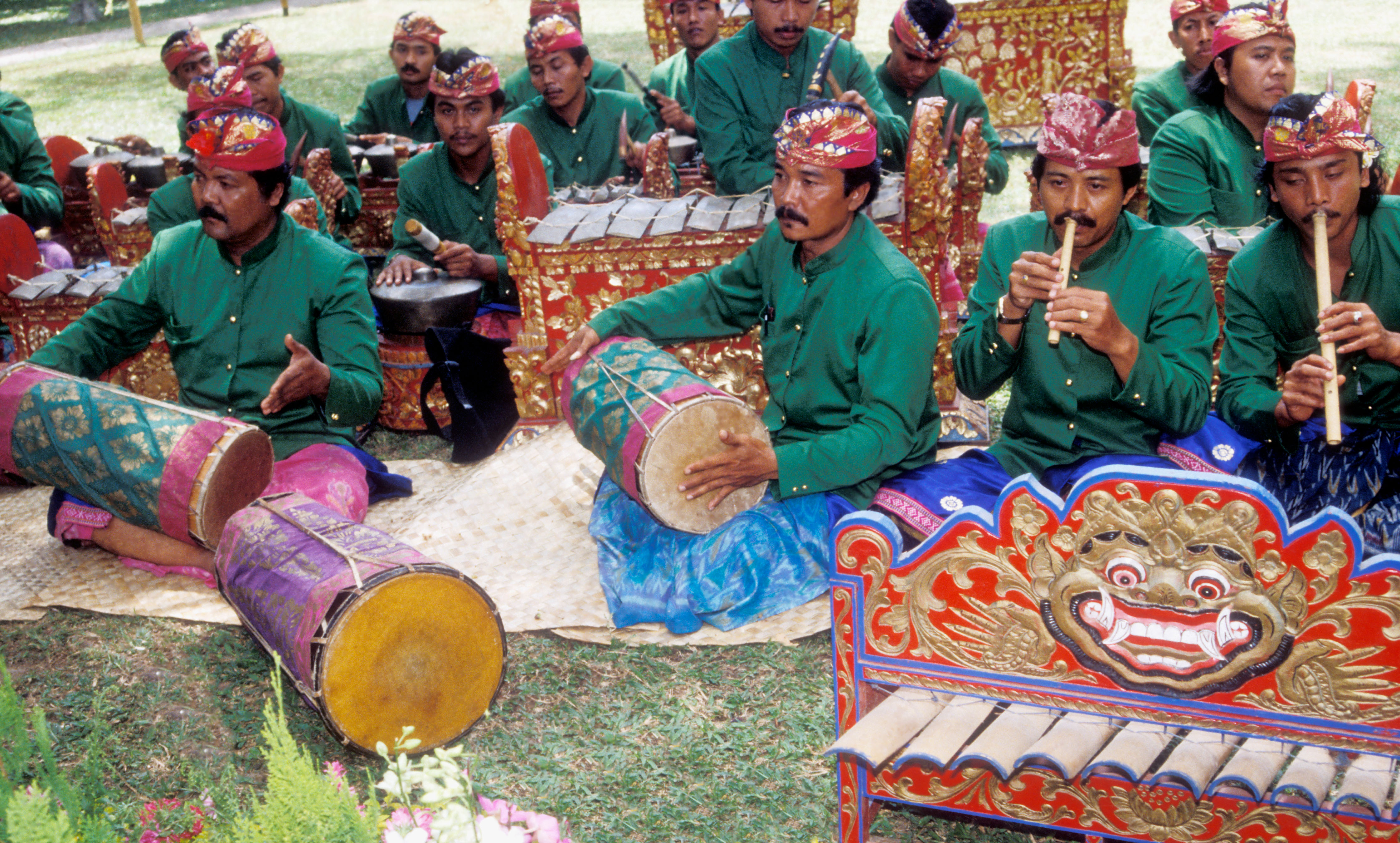
Some Indonesians, especially the Javanese, have only one name. They include the country’s first two presidents, Sukarno and Suharto.
Way of life
Rural life.
About half of the people of Indonesia live in small, rural villages. Life in most of these villages, called desas, is controlled by village headmen, religious teachers, and other traditional leaders. The village leaders govern by a traditional system that stresses cooperation. The villagers often settle disputes and solve problems by holding open discussions, called musyawarah, that continue until everyone reaches an agreement, known as mufakat.
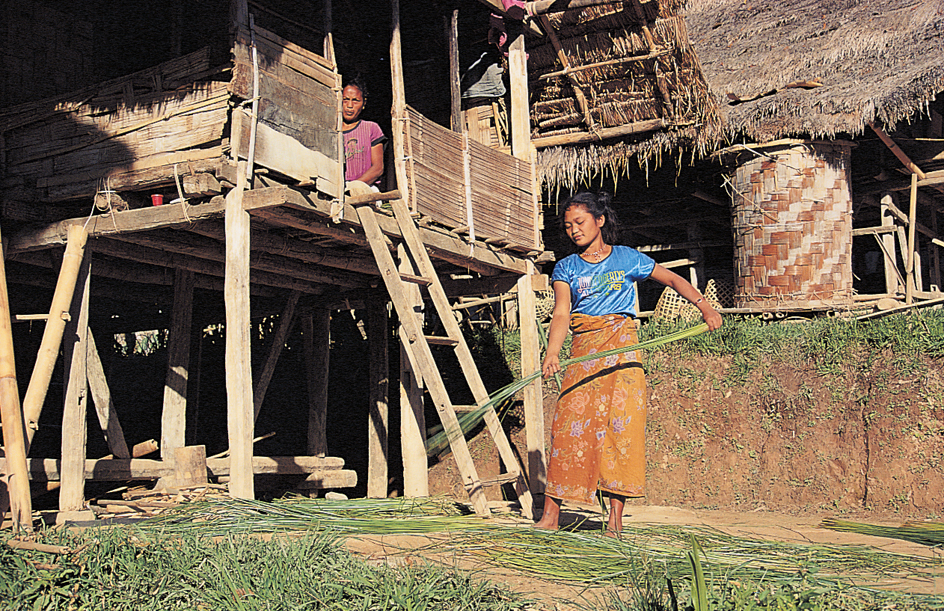
Life in small farm villages increasingly combines modern practices with older ways of life. For example, most villagers listen to the radio, shop in nearby towns, and send their children to public school. At the same time, they follow many ancient customs. For example, some villagers still build a traditional type of Indonesian house that stands on stilts about 6 feet (1.8 meters) high. Families use the space underneath for cattle stalls or chicken coops, or to store tools and firewood. The floors and walls are made of timber or flattened bamboo. The roofs are covered with clay tiles, palm thatch, or iron.
Some ethnic groups build large communal houses in which as many as several hundred people may live. These groups include the Dayaks on Borneo, the Toraja on Sulawesi, the Batak on Sumatra, and some Papuan groups in Papua.
City life.
City people live in American- and European-style houses and apartment buildings. Most of the largest cities of Indonesia are on Java. They include Jakarta, Indonesia’s largest city by far. Jakarta, Surabaya, and Medan have modern business districts with busy streets, elegant stores, and towering office buildings.
Clothing.
The traditional clothing of Indonesian men and women is a colorful skirt called a sarong or a kain. A sarong is a long strip of cloth wrapped around the body. A kain is similar, but with the ends sewn together. Men wear a shirt with trousers, or a sarong. Women usually wear a long-sleeved blouse and a sarong or kain.
The men often wear a special hat or cap, and women may wear a shawl over their shoulders or on their head. Unlike Muslim women in many other countries, those in Indonesia do not wear a veil over their face. In the cities, most people wear American- and European-style clothes, but some prefer the traditional clothing.
Food and drink.
The main food of Indonesians is rice, boiled or fried in various ways and served with a great variety of other foods. Indonesians eat their rice with meat, fish or a fish sauce, or vegetables; or they simply flavor it with hot spices. Indonesian cooks often simmer food in coconut milk and oil, and sometimes serve it wrapped in banana or coconut leaves.
The most commonly eaten meats are water buffalo, beef, and chicken. Indonesians eat little pork because most of them are Muslims, and their religion forbids eating it. Tea and coffee are favorite beverages.
People in the cities have a more varied diet than those in rural areas. Many city people eat Chinese, American, and European dishes as well as Indonesian foods.
Recreation.
Cockfighting, though outlawed, is a popular recreation in Indonesia, especially on Bali and in the Indonesian part of Borneo, called Kalimantan. On Madura, the people hold bull races and bullfights. A martial art called pencak silat is popular throughout Indonesia. Practitioners fight not only with their hands and feet but also with sticks and knives.
Many Indonesians enjoy European and American sports, especially badminton and soccer. Indonesians also like to bicycle, swim, and play tennis and volleyball.
Many people spend their evenings watching television or going to motion-picture theaters. Many movies are American or European films with subtitles in Bahasa Indonesia, but action pictures from Asian countries are also popular.
Religion.
About 80 percent of the Indonesian people are Muslims, and about 10 percent are Christians. Many of Indonesia’s Muslims follow Islam less strictly than other Muslims do. For example, many Indonesians combine ancestor and nature worship with Islam or Christianity. 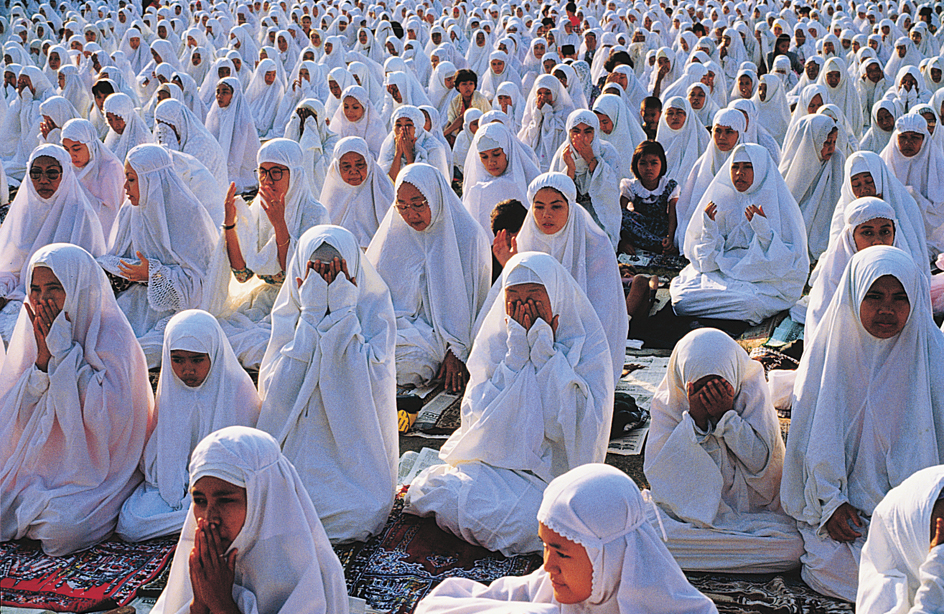
People on Bali and western Lombok follow a religion called Bali-Hinduism. It is based on Hinduism but includes ancient Balinese and Javanese beliefs. The Bali-Hindus worship the spirits of natural features, including mountains and large trees. They also honor the spirits of ancestors which, they believe, visit them. Bali has thousands of Bali-Hindu temples where the religion’s many holidays are celebrated with colorful festivals.
Buddhism and Hinduism were important religions on the islands hundreds of years ago. But Indonesia now has relatively few Buddhists or Hindus.
Education.
Almost all of Indonesia’s adult population can read and write. The government provides primary and intermediate schooling for a small fee. The government also helps support private schools. Children are required by law to go to school for nine years, beginning by age 7. Some parts of Indonesia lack enough schools, teachers, or textbooks. But overall, almost all Indonesian children attend primary school, about half attend intermediate school, and nearly one-third go to high school.
Indonesia has about 50 public and private universities. The largest is Gadjah Mada University in Yogyakarta. Only about 4 percent of Indonesia’s young people receive a college education.
The arts.
The most famous arts of Indonesia include two types of traditional dancing: the dances of the old royal courts of Java and the dramatic folk dances of Bali. Both types of dancers wear elaborate costumes and heavy makeup or masks. Javanese dances consist of slow, elaborate motions in which even finger gestures have a meaning. The dances may represent scenes of adventure, battle, or love. Balinese dances have quicker rhythms and more forceful movements. Many Balinese dances have a religious meaning and are based on ancient Hindu stories.
Loading the player...Indonesian ceremonial song
Wayang (shadow) puppet dramas are a major part of Javanese and Balinese culture. The most popular puppets are flat and made of leather, but wooden puppets are also used. The puppeteer sits behind a screen with a palm-oil lamp that throws shadows of the puppets onto the screen. Most wayang performances last all night.
On Java and Bali, a traditional Indonesian orchestra called a gamelan accompanies dances and puppet plays. A gamelan consists chiefly of metal percussion instruments, including gongs, xylophones, and double-ended drums. The orchestra also includes flutes and rebabs (two-stringed instruments that resemble lutes).
Beautiful stone sculptures decorate Indonesia’s many ancient Buddhist and Hindu temples. Famous temples include the Buddhist complex at Borobudur and the Hindu temples of Prambanan, both in central Java.

Early Indonesian literature consisted largely of local folk tales and traditional Hindu and Islamic stories. Literature became highly developed in many regional languages, especially Javanese. Modern literature written in Bahasa Indonesia began in the late 1920’s. Much of modern Indonesian literature is concerned with conflicts between Indonesian and European values and the relationship of traditional Indonesian values to the modern world. Pramoedya Ananta Toer, often considered the greatest Indonesian author, explored these and other themes in his series of four novels about Indonesia’s struggle against colonialism. The novels, all published during the 1980’s, are This Earth of Mankind, Child of All Nations, Steps Forward, and House of Glass.
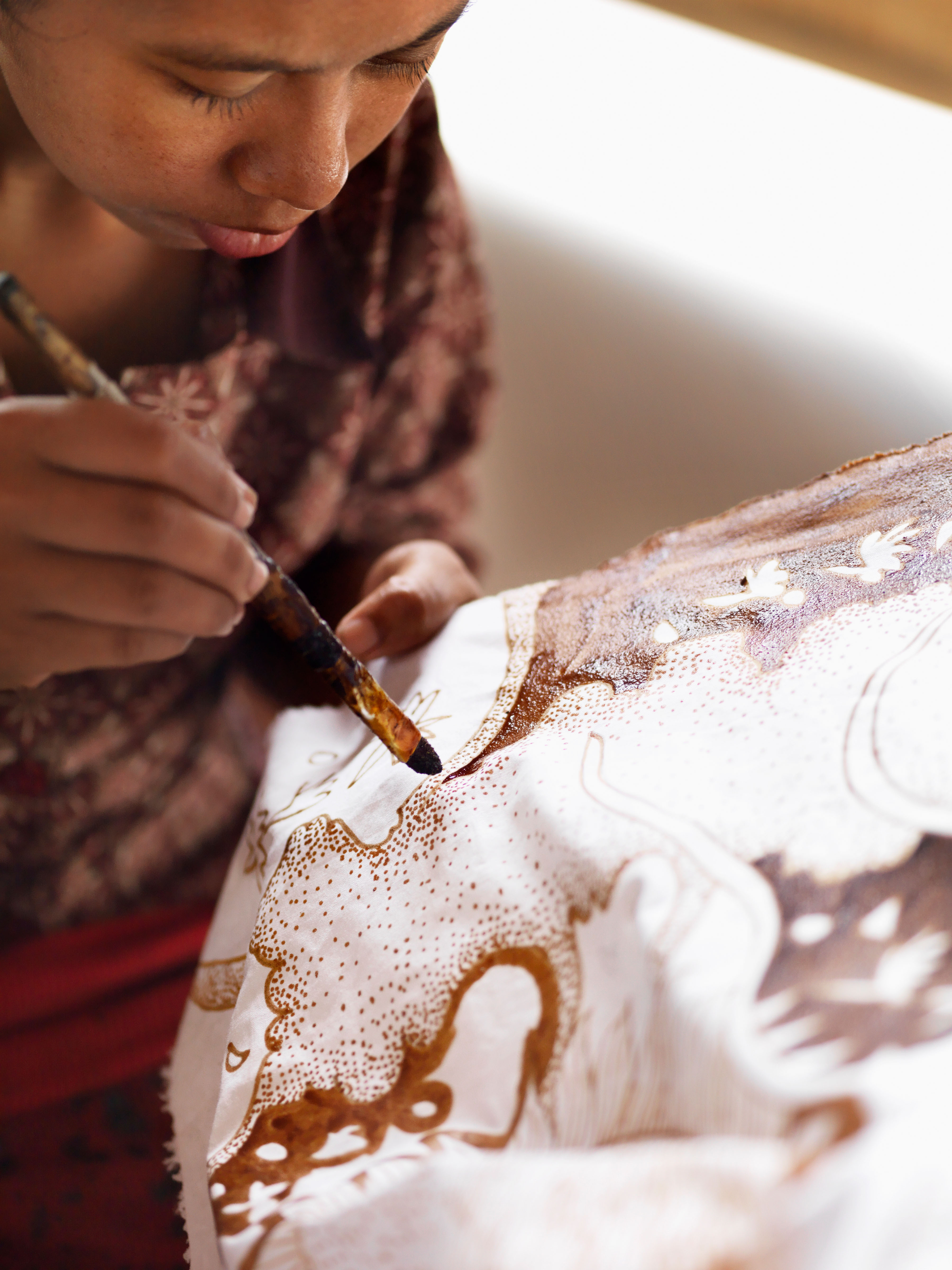
Famous Indonesian crafts include batik, a method of waxing and dyeing cloth to make beautifully colored fabrics. Craftworkers also make ceremonial daggers called krises. Some Indonesian peoples carve seated wooden figures to represent their ancestors. The Dayaks sculpt objects to ward off evil spirits. The Balinese carve Hindu figures and symbols for their homes and temples.
The islands
People live on more than 6,000 of the 17,500 islands of Indonesia. The rest of the islands are uninhabited. Many geographers divide the islands into three groups: (1) the Greater Sunda Islands, (2) the Lesser Sunda Islands, and (3) the Molucca Islands. Indonesia also includes Papua, which is part of the island of New Guinea.
The Greater Sunda Islands
include Borneo, Sulawesi (formerly called Celebes), Java (also spelled Jawa), and Sumatra (also spelled Sumatera). Most of the Indonesian people live on the Greater Sundas, and most of the nation’s economic activity is centered there.
Borneo
is the third largest island in the world, after Greenland and New Guinea. The southern three-fourths of Borneo is part of Indonesia. The other fourth consists of the independent nation of Brunei and two Malaysian states, Sarawak and Sabah. The Indonesian part of Borneo is called Kalimantan and is about the same size as France. Tree plantations, natural tropical rain forests, and mountains cover most of Kalimantan. The Kapuas River, the longest river in Indonesia, flows about 700 miles (1,100 kilometers) from the mountains to the sea. The low coastal plains are largely swampy. Kalimantan is thinly populated, and most of the people live along the coast. Samarinda is the largest city.
Sulawesi
is an island with four long peninsulas. It is the most mountainous island of Indonesia. Mountains in the central region average about 10,000 feet (3,000 meters) above sea level. Many volcanoes, some of them active, rise on the northern peninsula. Forests cover most of the mountain slopes. Some inland valleys and plateaus have fertile farmlands and rich grazing lands. Many of the coastal peoples fish for a living. Makassar is the largest city of Sulawesi and a major seaport.
Java
is Indonesia’s most densely populated and most industrialized island. It has about 7 percent of Indonesia’s total area and about 55 percent of the people. An east-west chain of mountains, including many old volcanoes, extends across the island. Wide, fertile plains lie north of the mountains, with limestone ridges to the south. A large highland plateau covers western Java.
Java’s rich volcanic soil supports intensive agriculture. Thousands of small farm villages dot the island. Most of Indonesia’s large cities are also on Java, including Jakarta, the capital and largest city. Because Java is so densely populated, the government began a resettlement program in the 1960’s to encourage Java residents to move to less crowded islands. Nevertheless, Java’s population continues to grow, but more slowly.
Java has 112 volcanoes, some of which are active. The remnants of the island of Krakatau lie off the coast of Java, in the Sunda Strait. In 1883, Krakatau erupted. Much of the island disappeared. The eruption caused a tsunami (series of huge sea waves) and pyroclastic flows (rapidly moving clouds of hot gas and ash). About 36,000 people on Java and nearby islands were killed by the tsunami and pyroclastic flows.

Sumatra
is the sixth largest island in the world. The Barisan Mountains, a range of volcanic peaks along the southwestern coast, rise about 12,000 feet (3,660 meters). The mountains slope eastward to a broad plain covered mostly by tree plantations, tropical rain forests, and some farms. Much of the eastern coast of the island is swampy. To the west, the mountains drop sharply to the sea. Sumatra has rich deposits of oil and natural gas. Medan is Sumatra’s largest city. In 2004, an undersea earthquake near Sumatra caused a tsunami that killed about 228,000 people in coastal areas of Asia and Africa, including about 168,000 in Indonesia.
The Lesser Sunda Islands,
which Indonesians call Nusa Tenggara, consist of two strings of islands extending between Bali on the west and Timor on the east. Indonesia controls the western part of Timor. The eastern part of the island is the independent nation of East Timor. Bali has the most people and the largest city, Denpasar. Most other towns in the Lesser Sundas are small, coastal trading centers. The islands have many mountains, and many short rivers flow from the mountains to the sea. 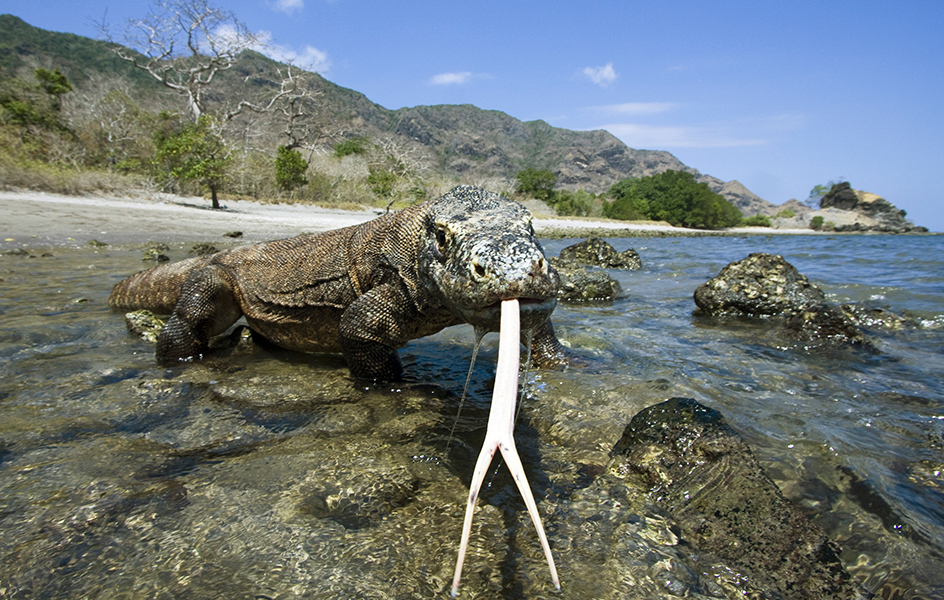
Timor and other islands in the east have fewer tropical rain forests and more dry grasslands than the islands in the west. Corn is the main crop in the eastern islands, but rice is the principal crop in the western islands.
The Molucca Islands,
which Indonesians call the Maluku Islands, lie in the northeastern section of Indonesia. Halmahera, the largest island of this group, covers 6,870 square miles (17,790 square kilometers). Halmahera, Ceram, and Buru are mountainous and thickly forested. The Aru and Tanimbar islands are flat and swampy. The Moluccas also include hundreds of ring-shaped coral reefs called atolls and other small coral islands that are uninhabited.
Most of the Moluccan people live in coastal trading settlements. Ambon, an important port on an island of the same name, is the largest city in the Moluccas.
The Moluccas were formerly called the Spice Islands, and they have long been famous for growing cloves, nutmeg, and mace. Through the centuries, the spice trade attracted people from many lands. These traders, including Arabs, Dutch, and Malays, intermarried with the Moluccans and greatly influenced their way of life. On some isolated islands, however, the people have kept many old customs. On the Tanimbar Islands, for example, people still make offerings to their ancestors.
Papua,
formerly known as Irian Jaya, covers the western half of the island of New Guinea and some small islands to the north and west. It was called Irian Barat (West Irian) until 1972, when its name was changed to Irian Jaya (Victorious Irian). In 2002, its name was changed to Papua. The eastern half of New Guinea is part of Papua New Guinea, an independent nation.
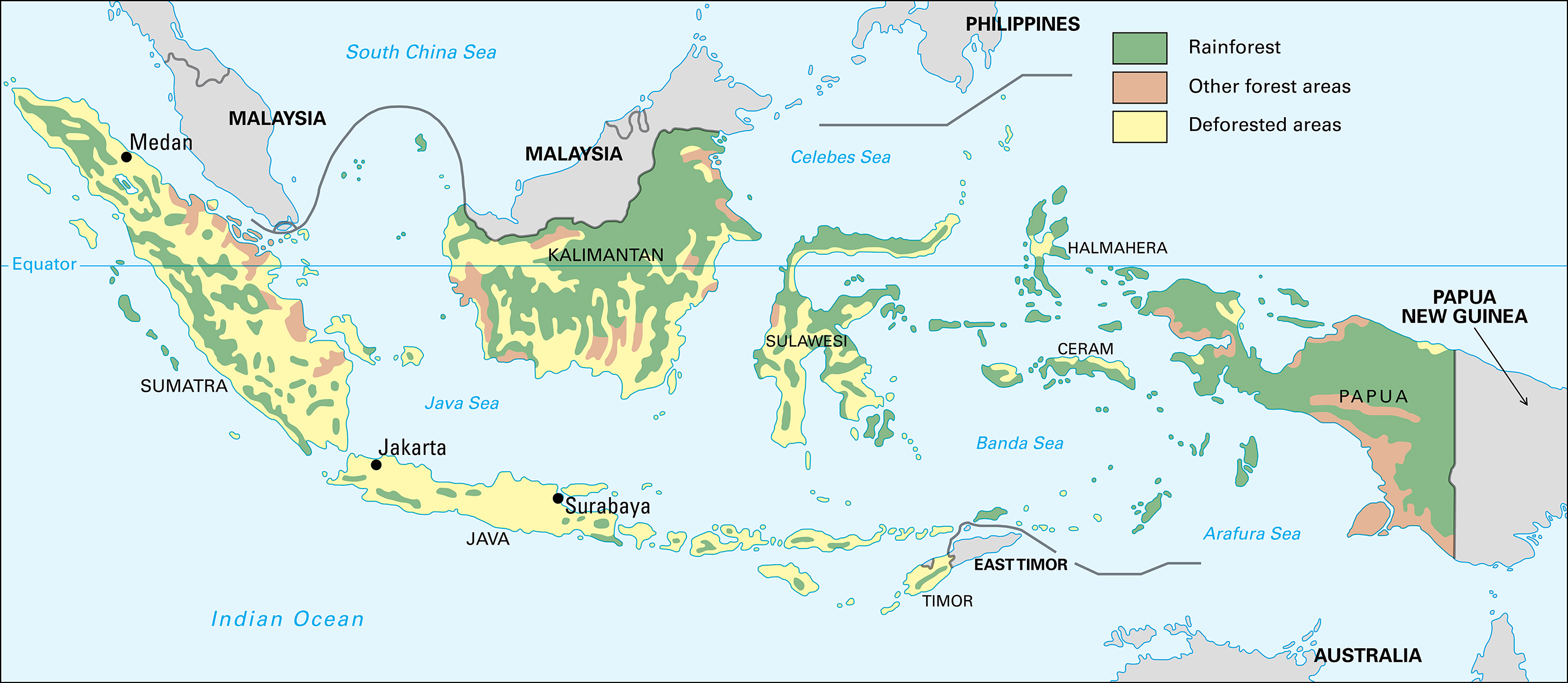
Papua is the least developed and most thinly populated region of Indonesia. Most of the population consists of Pacific Islanders called Papuans. The Papuans belong to a number of ethnic groups, several of whom live in isolated areas and follow traditional ways of life. The Asmat people, for example, are hunter-gatherers who live by hunting wild pigs and crocodiles and gathering the pulp of the sago palm.
To ease crowding on other islands, the Indonesian government sponsors a voluntary resettlement program that helps families move to Papua and other islands. Since the late 1960’s, more than 11/2 million people have moved from Java and Bali to Papua and other islands under this program.
Tropical rain forests cover about 85 percent of Papua. Towering mountains extend from east to west through most of the region. These mountains include 16,024-foot (4,884-meter) Puncak Jaya, the highest mountain in Indonesia. Rich deposits of copper and gold lie deep in the mountains. Most of the coastal areas are low and swampy, and some hold pockets of oil. Jayapura, Papua’s largest city, and other towns sit along the coasts. Most of the farmland also lies along the coasts.
Climate
Indonesia has a hot, humid climate. The average temperature is about 80 °F (27 °C), but temperatures are lower in the highlands. Temperatures vary little throughout the year. As a result, the seasons in Indonesia are based on differences in rainfall, not on changes in temperature. Java and the Lesser Sunda Islands have a distinct dry season in which significantly less rain falls. Rainfall is more evenly distributed throughout the year in other parts of the country, with heavier downpours in the wet season.
The wet and dry seasons are caused largely by two winds called monsoons. From December to March, the winter monsoon blows from the Asian mainland. This monsoon crosses the South China Sea, where it picks up moisture, and brings heavy rains to Indonesia. From mid-June to October, the summer monsoon brings dry air from Australia. West Timor, the part of Indonesia most affected by this wind, has the longest dry season—five months. Borneo and Sumatra, which lie farthest from Australia, have a shorter season of light rains.
The driest regions of Indonesia are in the Lesser Sundas, which receive from 35 to 40 inches (89 to 102 centimeters) of rain per year. The wettest islands, Borneo and Sumatra, get 120 to 145 inches (305 to 368 centimeters) per year. Some mountainous areas in Papua receive about 250 inches (635 centimeters) annually.
Economy
Indonesia’s economy is a mixed one, with both privately owned firms and state-owned enterprises. The private sector accounts for most of the total national output. About one-third of Indonesians work in agriculture and fishing, but diversified manufacturing has become a mainstay of the economy.
Service industries,
which produce services rather than goods, have become increasingly valuable to Indonesia’s economy. Today, service industries account for about half of both Indonesia’s employment and its gross domestic product (GDP). GDP is the total value of goods and services produced within a country in a year. Hotels, restaurants, and stores benefit from the millions of tourists who visit Indonesia each year. Many of these visitors come from other Asian countries and Australia. Visitors flock to the island of Java to see its beautiful scenery and famous temples, and to Bali, which is renowned for its dancing and colorful festivals.
Manufacturing.
Manufactured products account for much of Indonesia’s export earnings. The major industries include the manufacture of cement, chemicals, clothing, electronic equipment, food products, motor vehicles, paper products, plywood and other wood products, processed rubber products, textiles, and tobacco products. Most manufacturing plants are on Java. Jakarta and Surabaya are the leading industrial centers.
Agriculture
continues to be a major economic activity that employs about one-third of Indonesia’s workers. Indonesian farmers grow a large variety of crops, helped by fertile volcanic soil, a tropical climate, and plentiful rainfall. Many Indonesian farms are large plantations where workers raise crops for export, such as cocoa, coffee, copra (dried coconut meat), palm oil, rubber, sugar, tea, and tobacco. Indonesia is one of the world’s leading producers of each of these products. 
Rice, the chief food crop, is grown mostly on small farms. Indonesia is one of the world’s leading producers of rice. Indonesia’s government was an early supporter of the Green Revolution, an effort to boost grain production that began in the 1960’s. As a result, Indonesian farmers have long planted high-yielding varieties of rice. The farmers on Java grow much of Indonesia’s rice. They irrigate their fields with water from mountain streams and produce at least two rice crops a year.
Besides rice, small farms produce bananas, cassava, corn, fruit, peanuts, soybeans, and sweet potatoes. Farmers generally grow crops for sale as well as for their own use. Many farmers also raise beef and dairy cattle, goats, hogs, poultry, sheep, and water buffalo.
On several Indonesian islands, farmers practice slash-and-burn agriculture, also called shifting cultivation. They cut down forest trees and burn them, then plant crops in the clearing. The ashes from the burned trees enrich the soil. The farmers raise crops on the same land for only a few years. When the soil begins to wear out, they move.
Mining.
Indonesia is an important producer of oil and natural gas. Most of Indonesia’s petroleum comes from East Kalimantan and Sumatra. Indonesia is also a leading country in the mining of copper, nickel, and tin. Most of Indonesia’s copper comes from Papua. Nickel is mined on Sulawesi. The islands of Bangka and Belitung have many tin mines. Indonesia’s other mineral products include aluminum, bauxite, coal, gold, and silver.
Fishing industry.
Fishing is a growing industry in Indonesia, and many kinds of fish are caught in Indonesian waters. Fishing crews take anchovies, mackerel, sardines, tuna, scad, and other fish from the sea. People raise carp, milkfish, and prawns in coastal ponds, and a variety of freshwater fish in inland ponds. Fish provide a major part of coastal people’s diet.
Forestry.
Indonesia has abundant forests that are rich both in commercially valuable products and in wildlife. Forests cover about one-half of the country. Much of the forested area is used for commercial purposes. Indonesia’s chief forest products include plywood, teak, and timber. Other products from Indonesia’s forests include bamboo; mangrove bark, which is used to make dyes; and cinchona bark, which is used to make the malaria drug quinine.
Most of Indonesia’s wood products come from Kalimantan and Papua. Poor inland transportation has hampered the development of lumbering in other areas.
Energy sources.
Petroleum, natural gas, and coal provide most of Indonesia’s electric power. Hydroelectric, geothermal, and other sources supply the rest of the country’s electric power. PT PLN (Persero), which is owned by the government, generates much of Indonesia’s electric power.
International trade.
Indonesia exports about as much as it imports. Indonesia is one of the world’s largest exporters of natural gas. Oil and gas account for less than 10 percent of Indonesia’s total export earnings, down from more than 80 percent in the early 1980’s.
Indonesia’s most important exports include chemicals, clothing, copper, machinery, motor vehicles, palm oil, rubber, steel, and wood products. Major imports include chemicals, crude oil and petroleum products, electrical equipment, food products, iron and steel, machinery, and transportation equipment.
Indonesia’s most important trading partners include Australia, China, India, Japan, Malaysia, Singapore, South Korea, Taiwan, Thailand, and the United States. Indonesia belongs to the World Trade Organization, an international organization that promotes trade between nations.
Transportation and communication
are difficult in much of Indonesia because of the thick forests and rugged mountains, and the wide stretches of sea that separate the islands. Few Indonesians own an automobile. However, the number of people owning cars has been growing rapidly since the mid-1990’s. Buses and six- to eight-seat vehicles called bemos pick up and let off passengers along most roads. Indonesia has a good networks of roads. In some places, however, traffic must travel along jungle tracks or by riverboat. Railroads, which are owned by the government, operate on Java, Madura, and Sumatra. 
Transportation between islands is generally done by boat. Indonesia’s leading ports include Balikpapan; Belawan, near Medan; Makassar; Tanjung Perak, near Surabaya; and Tanjung Priok, near Jakarta.
A government-owned airline called Garuda Indonesia provides international and domestic air service. Several private airlines also fly within Indonesia. The main airport is Sukarno-Hatta International Airport at Cengkareng, near Jakarta. Indonesia also has international airports at Makassar and Medan and near both Denpassar and Surabaya.
The government runs the major radio and television stations. Several privately owned radio and TV stations also broadcast programs. A satellite communications system enables radio and TV programs to reach all of Indonesia’s provinces. Cell phone and Internet usage is increasing in the country.
Indonesia has dozens of daily newspapers. The most important daily papers include Pos Kota and Kompas, both published in Jakarta. Leading English-language papers include the Jakarta Globe and the Jakarta Post.
History
Ancient times.
Scientists have found fossilized bones on Java of one of the earliest species of prehistoric human beings. This species, called Homo erectus, may have lived there as early as 1.8 million years ago. See Java fossils.
Some handprints and animal drawings in caves on the islands of Borneo and Sulawesi are thought to be up to 44,000 years old. As early as 2,500 B.C., the ancient Indonesians made tools and ornaments of bronze or iron, wove cloth, and sailed the sea. They traded wherever they went, and established trade routes among the islands and with the Asian mainland. Gradually, the islands became a crossroads for commerce between Arabia and China. Merchants of many lands—Arabs, Chinese, Indians, and Persians—came to Indonesia for its spices and other riches.

Hindu and Buddhist kingdoms
were rivals for power in Indonesia for hundreds of years. The first strong kingdom was a Hindu state called Mataram, established in central Java in the A.D. 700’s. It soon fell to a Buddhist kingdom led by a line of rulers called the Sailendras. The Sailendras lost control of Java in the 800’s. Through marriage, they reappeared as rulers of a powerful Buddhist kingdom called Srivijaya, which had developed in Sumatra during the 600’s. Srivijaya became the region’s leading sea power. A new Hindu kingdom, also called Mataram, replaced the Sailendras in Java. Mataram and Srivijaya became bitter rivals.
In 1293, Prince Wijaya founded a kingdom called Majapahit. Majapahit became the first Indonesian kingdom to base its power on both agriculture and commerce. It conquered many other Indonesian lands and ended Srivijaya’s power. In the 1300’s, Majapahit claimed most of the islands.
The spread of Islam.
Muslim traders from Arabia and India were among the first people to bring Islam to Indonesia. But the religion’s main influence came later from Melaka (also spelled Malacca), a port kingdom on the southwestern coast of the Malay Peninsula.
During the early 1400’s, Melaka gained control of the important trading route through the Strait of Malacca, between Malaya and Sumatra. Melaka became a great warehouse center. Its ruler converted to Islam, and the religion spread to various parts of Indonesia.
The Majapahit kingdom fell in the early 1500’s. A new Muslim kingdom—the third kingdom in Indonesia to be called Mataram—arose on its ruins. Mataram reestablished a united kingdom in central and eastern Java.
The coming of the Europeans.
In 1497 and 1498, the Portuguese explorer Vasco da Gama sailed around Africa and discovered a sea route from Europe to India. Other Portuguese explorers soon followed. The Portuguese captured Melaka in 1511, built a fort there, and tried to take over the profitable Indonesian trade.
By the end of the 1500’s, the English and Dutch began to challenge the Portuguese for control of Indonesia’s riches. England and the Netherlands each formed an East India Company to trade in the region, the English in 1600 and the Dutch in 1602. In 1641, the Dutch captured Melaka from the Portuguese.
Dutch rule.
In 1677, the ruler of Mataram on Java asked the Dutch to help him fight a rebel uprising. The Dutch did so, and he gave them important trading rights and Javanese territories. In similar ways, or by force, the trade on other Indonesian islands passed into Dutch hands. By the late 1700’s, the Dutch East India Company controlled commerce on most of the islands. The region became known as the Dutch East Indies or the Netherlands Indies.
The Dutch East India Company forced the Indonesians to produce certain crops and deliver them at prices set by the company. The company made enormous profits at first. But its costs grew rapidly during the late 1700’s, and it went bankrupt. Legislation by the Dutch government in 1798 caused the company to disband the next year. The government took over the company’s land.
At first, the Dutch government established effective political control mainly on Java. Beginning in 1830, the Dutch government forced peasants throughout Java and in parts of Sumatra and Sulawesi to grow such export crops as indigo and coffee on much of their land. The Dutch government collected these crops and made large profits from their sale. In 1870, it permitted Dutch investors to lease farmland in the region. In the next 30 years, many privately owned Dutch plantations went into operation, most of them on Sumatra. The Dutch government gradually extended its control throughout the East Indies, partly by conquest and partly through agreements with local rulers. By about 1910, the final extent of the Netherlands Indies had been established.
The rise of nationalism.
Indonesians in several areas had long resisted Dutch rule. In 1825, a major revolt began on Java under Diponegoro, a Javanese prince. Fighting continued until the Dutch crushed the revolt in 1830.
Budi Utomo, the first nationalist organization, was founded in 1908 and won support among well-educated Javanese. It was a cultural association rather than a political party. In 1912, the Islamic Association, originally a Javanese trading society, became political and developed into a serious challenge to the Dutch. To quiet nationalist demands, the Dutch set up a People’s Council with some Indonesian representatives on it. But the council had little power beyond that of debate. The Indonesian Communist Party, formed in 1920, led a series of minor revolts in 1926 and 1927. Many other anti-Dutch parties also developed, including the Indonesian National Party, founded in 1927 by Sukarno.
Independence.
On Jan. 11, 1942, during World War II, Japanese forces landed in the Netherlands Indies. On February 27, the Japanese defeated an Allied fleet in the Battle of the Java Sea. In the world war, Japan fought on the side of Germany, Italy, and the other Axis nations, and the Netherlands sided with Britain, the United States, and the other Allies. Allied forces in the Netherlands Indies surrendered to Japan on March 9. Many Indonesian nationalists cooperated with the Japanese but continued to work for independence. On Aug. 17, 1945, after Japan had agreed to surrender to the Allies, Sukarno and other nationalists declared Indonesia’s independence. Sukarno became the nation’s first president.
The Dutch tried to regain control of Indonesia. From 1945 to 1949, there were periods of fighting and a series of truces. The Dutch recaptured much territory but could not defeat the Indonesians. For the many peoples of Indonesia, the revolution strengthened their belief in nationalism and their sense of Indonesian identity. Under pressure from the United States and the United Nations (UN), the Dutch finally agreed to grant independence to all the Netherlands Indies except West New Guinea (now Papua). That territory’s future was to be decided at later conferences. The Netherlands formally recognized Indonesia’s independence on Dec. 27, 1949.
Indonesia under Sukarno
faced serious problems. Only the natural resources needed by the Dutch had been developed. Transportation systems were inadequate. About 90 percent of the population could not read or write, and few people were qualified for high positions in government or business. Regional and ethnic differences threatened to divide the country. There was little agreement on how to solve Indonesia’s serious economic and social problems. Parliamentary elections, held in 1955, continued the political confusion by failing to produce a majority party. Revolts broke out on Sumatra and Sulawesi in 1958, but Indonesian Army units from Java defeated all the rebels by 1961.
In 1960, Sukarno dissolved the elected parliament and appointed a new one. He called his system of government “guided democracy.” In 1963, the People’s Consultative Assembly declared him president for life.
Sukarno had repeatedly demanded that the Netherlands turn over West New Guinea (now Papua) to Indonesia and threatened to seize it by force. In 1962, the Netherlands gave temporary control of West New Guinea to the UN. The following year, the UN gave Indonesia responsibility for administering the area. In 1969, the region’s people voted to remain part of Indonesia. The UN recognized Indonesia’s control of West New Guinea, which was renamed Irian Barat (West Irian).
In 1963, the country of Malaysia was established over Indonesia’s opposition by combining the British colonies of North Borneo (Sabah) and Sarawak with Malaya and Singapore. Indonesia claimed that the United Kingdom had granted Malaysia a false independence and kept the real power. Indonesia also declared that the British had forced North Borneo and Sarawak to join the new nation. Sukarno threatened to crush Malaysia. In 1964, he sent Indonesian forces into the new nation. They were unsuccessful, chiefly because of British military support for Malaysia. In 1965, Sukarno withdrew Indonesia from the UN to protest Malaysia’s election to the UN Security Council.
The fall of Sukarno.
Sukarno succeeded in giving his people a sense of national identity and pride. But the Sukarno government mismanaged Indonesia’s economy, and the country almost went bankrupt. Beginning in 1957, Indonesia seized many foreign-owned plantations and industries, but it did not have enough trained people to run them. Most of the plantations and industrial plants came under the control of Army administrators. Sukarno spent huge sums on such projects as monuments and sports stadiums, but he neglected the development of natural resources. The country’s exports fell, and its debts rose. Inflation drove prices up sharply.
During the 1960’s, the Indonesian Communist Party gained strength. Communists controlled labor unions and other key organizations, but they held few government posts. In 1965, military officers associated with the Communist Party tried to overthrow the government. They killed six generals and some other officers. The Army, led by Lieutenant General Suharto, quickly defeated the rebels. Over the next several months, civilian mobs retaliated against the Communists, killing more than 200,000 people.
Indonesia under Suharto.
In 1966, pressure from the Army and student groups forced Sukarno to transfer much of his power to Suharto. Suharto outlawed the Communist Party, dismissed many government officials, and appointed new ones. He ended Indonesia’s opposition to Malaysia and brought Indonesia back into the UN. By 1967, Sukarno had lost his remaining power, and Suharto became acting president. The next year, the People’s Consultative Assembly elected Suharto president. The Assembly reelected Suharto as president every five years from 1973 to 1998.
When Suharto became president, Indonesia’s economy was weak. The country could not grow enough rice to feed its people, foreign banks would not lend money to the Indonesian government, and the inflation rate was about 1,000 percent a year. Suharto’s government, backed by a strong military, created economic and political stability. The government received large amounts of foreign loans and investment. It funded projects to increase rice production, and yields rose sharply. The government also improved health conditions in Indonesia and helped raise living standards in other ways.

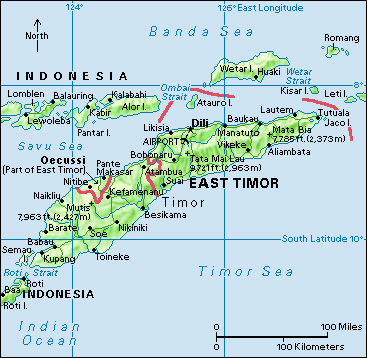
During the late 1960’s and throughout the 1970’s, several uprisings broke out in Irian Barat, which was renamed Irian Jaya in 1972. The rebels, who called themselves the Free Papua Movement, opposed Indonesian rule. Indonesian government troops largely put down the uprisings, but some fighting along the border with Papua New Guinea continued.
World prices for petroleum products had soared in the 1970’s, greatly aiding Indonesia’s economy. Oil prices fell in the mid-1980’s, however, slowing economic growth. As a result, Indonesia worked to diversify its economy and become less dependent on oil and gas. Exports of wood products, coffee, rubber, shrimp, and manufactured goods increased. Diversified manufacturing and strong industrial growth, particularly on Java, brought prosperity in the late 1980’s and early 1990’s.
The fall of Suharto.
Opposition to Suharto gained strength in the mid-1990’s. Many people criticized the Suharto family’s immense wealth and its control of key government agencies and economic enterprises. Corruption in government also drew criticism. 
In 1997 and 1998, Indonesia suffered one of the worst financial slumps in its history. The value of its currency fell, and its stock market plunged. Banks and other businesses failed, and millions of people lost their jobs. Meanwhile, the price of food and other necessities soared. The economic downturn led to renewed calls for Suharto to step down. Violent protests broke out in Jakarta and some other major cities. In May 1998, Suharto resigned. Vice President B. J. Habibie succeeded him. Habibie promised to pursue a program of economic, political, and social reforms.
The rise of Megawati.
In June 1999, the Indonesian Democratic Party of Struggle, led by Megawati Sukarnoputri, received the largest number of votes in elections for the House of Representatives. Megawati is a daughter of Indonesia’s first president, Sukarno. In October, the People’s Consultative Assembly chose Abdurrahman Wahid as president and Megawati as vice president. Abdurrahman headed the National Awakening Party and an alliance of other Islamic parties. 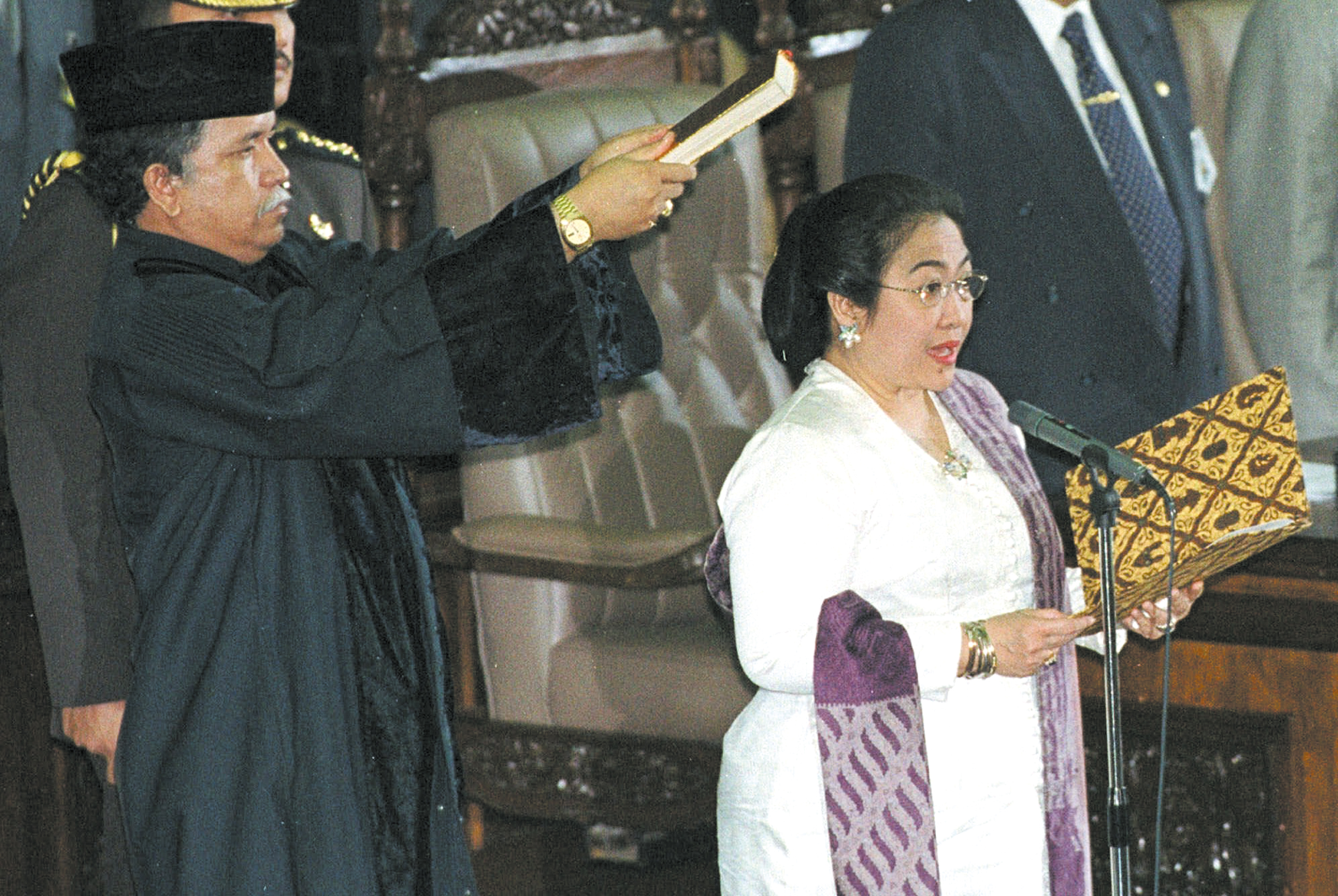
Abdurrahman faced a number of problems as president. Encouraged by the Indonesian government’s decision to grant independence to East Timor, groups in Aceh and Irian Jaya renewed their calls for independence for those regions. In addition, ethnic and religious violence continued to flare up throughout Indonesia. In 2000, Christians and Muslims engaged in a series of bloody clashes in the Molucca Islands, and ethnic violence rocked Borneo in 2001. Muslim extremist groups became more active throughout the country.
Abdurrahman faced growing criticism of his administration, as well as corruption charges. Indonesia’s parliament threatened to throw him out of office, and he, in turn, threatened to disband the parliament. In July 2001, a special session of the People’s Consultative Assembly voted to remove Abdurrahman from office. Megawati became the country’s new president.
In 2002, Indonesia gave Irian Jaya greater control over local affairs. It also renamed the region Papua, the name preferred by people native to the area. In 2003, Indonesia began a process of splitting Papua, which had been one province, into three separate provinces. Many Papuans strongly protested against the split, and some protests became violent. In 2004, Indonesia’s Constitutional Court issued a ruling that had the effect of splitting Papua into only two provinces rather than three.
In the early 2000’s, a number of terrorist attacks occurred in Indonesia. The most serious attacks happened in October 2002, when terrorists bombed two nightclubs in Bali that were popular with foreign tourists. The explosions destroyed the clubs and killed about 200 people, most of whom were tourists. Several Muslim extremists have been convicted and given prison or death sentences for their roles in the bombings.
In December 2002, Indonesia’s government reached a peace settlement with separatist rebels in Aceh. However, the agreement collapsed the following year. In May 2003, Indonesia imposed martial law in Aceh and began a military campaign against the rebels. In May 2004, Indonesia ended martial law but continued its military campaign.
In April 2004, elections were held for a newly reorganized legislature in Indonesia, with all members elected by the people. The Golkar party won the largest number of seats in the House of Representatives. The Indonesian Democratic Party of Struggle finished a close second. In July and September 2004, Indonesia held its first direct presidential election. Two rounds of voting were required, because no candidate received a majority of votes in the first round. Retired General Susilo Bambang Yudhoyono of the Democrat Party won the election, defeating Megawati.
Recent developments
In December 2004, a powerful undersea earthquake in the Indian Ocean near Sumatra generated a series of large ocean waves called a tsunami. The tsunami’s towering waves killed about 228,000 people in coastal areas of South Asia, Southeast Asia, and East Africa. It also left millions of people homeless and caused billions of dollars of property damage in the region. Indonesia was by far the hardest hit country, with about 168,000 deaths. The western and northern coasts of Sumatra were especially devastated. 
After the tsunami, Indonesian government forces and Acehnese rebels declared an informal truce to allow aid to reach Aceh. In 2005, leaders of the two sides held a series of talks in Finland. They signed a peace agreement in August 2005. In December, the rebels dissolved their military arm and gave up their weapons to international officials as part of the agreement. That same month, the Indonesian government withdrew over 24,000 troops from Aceh. In July 2006, the Indonesian parliament passed a bill granting Aceh more autonomy (self-rule), and the province held elections in December.
In May 2006, a major earthquake struck the island of Java, south of Yogyakarta. More than 5,800 people were killed. A tsunami crashed into the southern coast of Java in July, killing over 600 people. In 2009, Yudhoyono was reelected president. In 2014, voters elected the governor of Jakarta, Joko Widodo, to the presidency.
In September 2018, a powerful earthquake hit Sulawesi, triggering a tsunami. The disasters killed more than 2,000 people, mainly in the coastal city of Palu. In December, an underwater volcano in the Sunda Strait erupted and set off another tsunami, killing more than 400 people on Sumatra and Java.
Voters reelected Joko Widodo as president in 2019. Beginning in early 2020, Indonesia and many other nations faced the challenges of the COVID-19 pandemic (global epidemic). Indonesia experienced its largest surge in serious cases of COVID-19 from June to August 2021. In 2022, the Indonesian parliament passed laws that divided the two provinces in the Papua region into a total of six provinces. The government said that the changes would aid regional development. However, some people in Papua claimed that the changes were meant to decrease their autonomy. 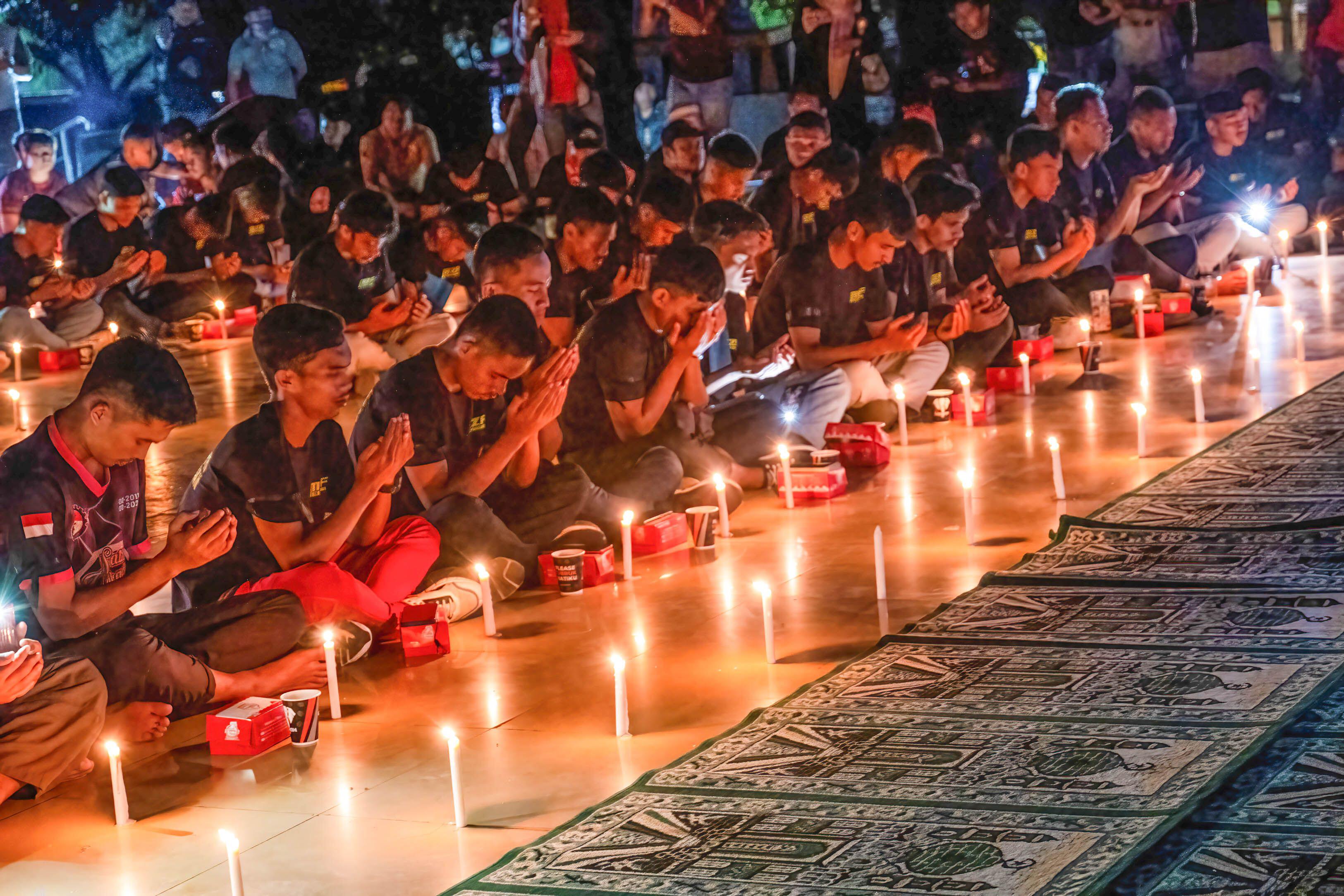
In 2022, construction began on Nusantara, a new Indonesian capital on the island of Borneo. This project was intended to reduce overcrowding in Jakarta and to promote economic growth. Nusantara was scheduled to replace Jakarta as Indonesia’s capital in 2024. Construction of the new city was expected to continue until 2045. In 2024, former general Prabowo Subianto was elected president of Indonesia.
